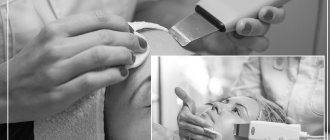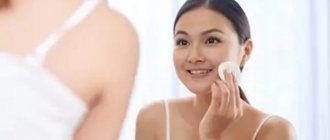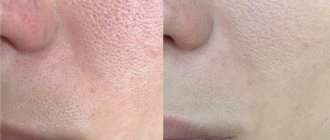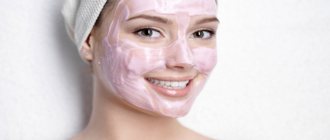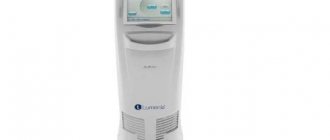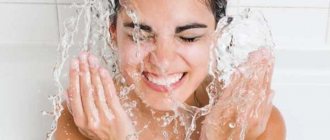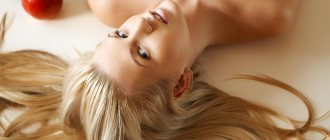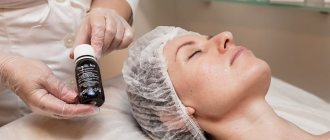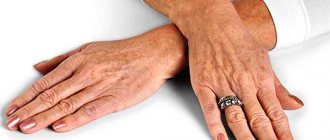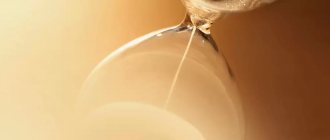Deep skin cleansing: types, indications and contraindications
Deep cleansing of the skin is an effective cosmetic procedure that allows you to achieve rejuvenation of the face, neck, and décolleté, giving them a healthy and firm appearance.
Such techniques are aimed at combating age-related signs of aging and a lack of collagen in tissues, due to the small amount of which a loss of elasticity occurs. The skin becomes flabby, deep wrinkles appear, as well as various pigmentation. All these age-related signs of aging can be effectively hidden by deep cleansing the facial skin.
Below you will learn basic information about such methods and stages of skin cleansing. We will also describe in detail the indications and contraindications for procedures that will help you decide on the appropriate method for effectively cleansing your face and returning it to its youthful natural state.
What is the difference between the procedure of deep cleansing the facial skin and the use of standard masks, cosmetic creams and gels?
The main difference is the depth of impact on the skin. Superficial peels, masks, massages and creams affect and penetrate only the top layer of skin - the epidermis. When deep cleaning the skin, cosmetology centers and aesthetic beauty salons use special techniques and products that affect both the epidermis and the lowest layer of skin tissue - the dermis to the reticular layer.
- The top layer of the epidermis consists only of dead, anucleate cells with flat skin flakes. Underneath them are the cells of keratinocytes, epidermocytes and melanocytes.
- In the middle and deep layers of the skin there are fibroblasts, which are responsible for the production of collagen and elastin fibers. They are responsible for the elasticity, firmness and firmness of the skin. Standard methods of facial cleansing will not be able to stimulate the activation of these components.
When deep cleansing the face, all these layers are affected. Almost all methods are based on damage to a number of cells, after which regeneration processes are activated in the body. Dead and old cells are removed from the surface of the tissue, and in their place new ones are opened - young and rich in collagen and elastin. After restoration, the skin returns to its natural healthy appearance.
Features of daily facial cleansing at home
We answer the main questions about cleansing facial skin at home:
How to choose the right cleanser?
The best way to make a choice is to focus on your skin type and the ingredients that are beneficial for it.
- For oily and problem skin, foams and wash gels containing mattifying, sebum-regulating and bactericidal components are suitable. They will help cope with blackheads, pimples, sebaceous shine and enlarged pores. Salicylic acid and zinc are a must have in the composition!
- For dry skin, products with oils and moisturizing ingredients are suitable. They will help saturate it with moisture and restore the hydrolipidic barrier.
- Normal skin needs cleansing just as much as other types. Both gels and foams are suitable for her, especially if they contain natural plant extracts (grape, apricot, etc.).
- Those with sensitive skin can try washing without water - using cleansers with the most delicate formulas and soothing ingredients in their composition.
- Combination skin needs special care: in the T-zone it suffers from excessive oiliness, and in the U-zone it suffers from a lack of lipids. Micellar water is suitable for removing makeup, and gel with plant extracts is suitable for washing.
Basic rules for cleansing facial skin
- Cleansing too frequently or aggressively is just as dangerous as not cleansing enough. By washing our face over and over again, we can dehydrate the skin and disrupt its protective barrier, so it is necessary to cleanse the skin twice a day - morning and evening.
- In the morning, to cleanse your face, washing with gel or foam and toning is enough. In the evening, it is imperative to remove your makeup, otherwise in the morning you will have a panda look and inflamed skin.
- All cleansers should suit your skin type!
- Regular soap for washing will not work. It contains aggressive surfactants that will disrupt the pH balance of the skin and will almost certainly lead to increased dryness.
- You need to have a separate towel for your face. It is important to blot the skin with it and not rub it.
How important are water quality and temperature?
If you know that the tap water in your home leaves much to be desired, use filtered or bottled water. It is best to wash your face with lukewarm water: hot water dries the skin and stimulates the sebaceous glands, while cold water constricts blood vessels and impairs blood circulation.
Mechanical deep cleansing of the face without the use of chemicals
It is carried out by cosmetologists in 5 stages:
- No. 1. Makeup remover using water-based balms and toners. Moisturizes the skin and prepares it for the procedure
- No. 2. Steaming with a vaporizer to soften the tissue, open pores and enhance the penetration of active ingredients, which are subsequently applied to the skin.
- No. 3. Manual cleansing is carried out by a cosmetologist over the entire face, which allows you to remove dead cells from the surface, open clogged pores and restore skin tone.
- No. 4. After cleansing, a soothing mask is applied to the face, and then, after removing it, a toning cream or compositions are applied. They are necessary to help the skin quickly cope with irritation and recover from mechanical impact on the epidermis.
- No. 5. The final stage of the procedure is the application of a softening cream and compositions with medicinal components and vitamins for additional nutrition and moisturizing of the skin.
This deep cleansing of the face allows you to get rid of problems with uneven complexion, clogged pores, acne and sagging. It is recommended to carry out the procedures in sessions every 1-2 months to achieve maximum effect.
Contraindications:
- Pregnancy and lactation period;
- Severe forms of epilepsy and hypertension;
- Presence of infectious and inflammatory diseases in the cleaning area
- Skin hypersensitivity, the presence of wounds, as well as individual allergic reactions to the compositions.
Step-by-step instructions for cleansing and caring for your skin
Daily cleansing of facial skin is a beauty ritual that involves at least three skincare products. How to carry it out according to all the rules at home? Follow our instructions!
Makeup removal
Makeup removal is the first stage of evening skin care. You will need micellar water, milk or makeup remover lotion. They dissolve particles of cosmetics and are easily removed from the skin with a cotton pad. To avoid stretching the skin, move along the massage lines and never rub your eyes. Apply makeup remover to cotton pads and place them on your eyelids for 20-30 seconds, then gently remove any remaining makeup. By the way, you know that you will need a separate product for eye makeup remover, right?
Washing
Washing with water is not enough for cleansing, even if we are talking about a morning ritual. Why is that? While we sleep, our skin is actively regenerating and secretes sebum - sebum, which must be gotten rid of before the next stage of care. Foam or gel for washing will help!
Intensive cleansing
For peeling (removing dead skin cells) you will need a good scrub: use it 1-2 times a week, especially if the skin is oily or prone to inflammation. Just remember that scrubs should not be used during an exacerbation of acne or acne! This can spread bacteria all over your face. For deep cleansing, masks based on clay or activated carbon are suitable (they will help you forget about blackheads).
Toning
Essentially, a tonic is a transparent or translucent liquid in which active ingredients are dissolved. What is his superpower?
- Completes the cleansing process by drawing out remaining impurities and skincare products from the pores.
- Restores pH balance, which is almost certainly disturbed by cleansers.
- Prepares the skin for the next stage of care (tonic is an ideal “conductor” between the skin and care cosmetics).
- The main types of toners: cleansing, moisturizing and mattifying.
Deep chemical cleansing of facial skin
The chemical peeling procedure is carried out using special preparations and acid-based compounds. The principle of the method is an active effect on the upper layers of the skin with deliberate injury to dead and old cells. As a result of a mild chemical burn of the tissue and removal of the dead layer, cosmetologists are able to discover hidden living cells rich in collagen and elastin on the surface.
For deep chemical cleaning, fruit, trichloroacetic, salicylic acids, as well as preparations based on the main component - phenol, are used.
The procedure is accompanied by painful sensations and a long rehabilitation period (from 1 to 6 weeks), which is necessary for completely old cells to expose new smooth and healthy tissue.
Important: The effect of deep chemical cleaning is superior to all other cosmetic procedures. Although redness and swelling of the skin are observed in the first week, after complete recovery the face is completely rejuvenated, regaining its natural brightness, firmness, color and elasticity.
- Fruit and alpha acids with a moisturizing and anti-inflammatory effect are used for the surface layers of the skin.
- For the middle layers of the skin, solutions of trichloroacetic and salicylic acid are used, which allow you to get rid of skin spots, pigmentation, decreased turgor and other age-related changes.
- To clean deep layers, phenol-based compounds are used. In this way, you can completely get rid of deep wrinkles, folds, sagging skin and signs of photoaging.
The procedure is carried out by analogy with manual mechanical cleaning. First, make-up is removed and preliminary preparation of the facial skin is carried out using moisturizing and softening compounds. Acid-based solutions and masks are applied, and then the cosmetologist cleanses the skin of dead particles. At the end of the procedure, soothing masks and creams are reapplied, which accelerate the recovery and regeneration of the treated areas.
Contraindications:
- Inflammatory skin diseases, the presence of infectious and autoimmune diseases
- The presence of open wounds, rashes, irritations and dermatological symptoms of skin diseases
- Individual drug intolerance, allergies and hypersensitivity
- Pregnancy and lactation period
- Oncology
Important:
The best indication for choosing a specific deep facial cleansing procedure is a direct consultation with a cosmetologist.
Only a specialist, depending on your skin type and individual characteristics of your body, can offer a suitable method for cleansing and rejuvenating your face. Call us by phone or leave your request to schedule a consultation with our cosmetologists.
How to properly care for your skin, knowing its type
Skin type directly depends on the content of fat and moisture in it. Therefore, they distinguish normal, oily, dry and combination (mixed type).
Normal skin
This type of skin is characterized by a clean and fresh appearance. The skin is taut, elastic and does not flake at all. Uniform blood supply allows the skin to acquire a pink tint. The normal type is characterized by smoothness and elasticity, as well as sufficient moisture and fat lubrication. Due to this, pores, blackheads and wrinkles are practically invisible. It is very rare to find representatives of the fair sex with this skin type.
Normal skin tends to renew itself, meaning that after the outer layer is peeled off, a new one is always created. This type of dermis is not characterized by tightness, dryness and oiliness. How to properly care for your facial skin to keep it youthful and healthy?
- Use gel or milk to wash your face; try not to use soap more than once a week.
- You can cleanse your skin with tonics containing alcohol.
- To moisturize the skin, you can use nourishing creams.
Oily skin
This type of skin has increased greasiness, so the skin is very shiny and clogged. Due to excess fat, pimples and blackheads appear, the skin looks dirty. However, oily skin also has its advantages. Due to the secreted fat, it becomes insensitive and protected from external factors. Since moisture from the surface of the skin does not evaporate due to the fat layer, this allows the owner of oily skin to remain young for quite a long time. Plus, by the age of 30, such skin becomes a mixed type.
We will describe how to properly care for oily skin. The most important thing is cleansing.
Oily skin is prone to breakouts because bacteria can grow in the sebaceous glands. To prevent this from happening:
- Wash your face not with hot water, but with warm or cool water to soothe the skin; do not use soap, because it causes the sebaceous glands to actively begin to work. When cleansing, opt for sponges and gels that dissolve in water.
- Do massages using a brush, this is very good for oily facial skin. If you also use special milk, then the pores will be cleansed.
- Take care of inflamed skin in such a way as to ensure its recovery and clearing of acne. To do this, use salicylic acid-based lotions.
- Forget about fatty creams, better use a 5% solution of tea tree oil.
Dry skin
Dry skin can vary in origin and appearance. Young and middle natural ages account for a variety of “natural” skin. It is delicate, thin and matte. Pores are not visible on the surface of the skin, but wrinkles are noticeable. If you don’t take special care, peeling will form and you will feel tightness or irritation.
Recommended articles on the topic:
- Facial mesotherapy procedure: pros and cons
- Beauty injections: types of drugs, reviews
- Placental therapy is the secret of eternal youth
This type of skin does not tolerate any temperature changes and reacts poorly to soap, various ointments and creams. If the skin is very dry, perhaps your body does not have enough dietary fats, the cause may be diseases of the liver, pancreas, as well as a lack of vitamins A, C, PP.
How to properly care for dry facial skin if you are worried about flaking and tightness? The most important thing is to moisturize it, this way you can prevent the appearance of wrinkles in the early stages.
- Use products for this skin type when washing your face. These can be tonics for removing makeup or medicinal herbal decoctions.
- Do not use masks if they contain petroleum products. This will harm the skin and make it difficult to breathe.
- Be careful when using scrubs. Choose products that do not cause allergies and are gentle on your skin.
- Choose soft creams, use them at night to create a protective film on the skin, and you can also alternate masks for moisturizing and toning.
Combination (mixed) skin
This is the most common skin type. As a rule, fatty grease is distributed on the forehead and chin, so oily sheen is concentrated in this area, causing acne and pimples, while the cheeks and area around the eyes, on the contrary, are dry, so the skin flakes and becomes wrinkled. You should always consider how to properly care for combination skin.
In adulthood, mixed skin will turn into normal skin. The skin begins to age at the age of 14; closer to 30 years, its withering is noticeable, which manifests itself in poor regeneration, thickening of the stratum corneum, and the appearance of wrinkles due to lack of hydration.
At 50 years old, the skin is no longer so elastic and smooth, especially in the nasolabial area; wrinkles in the eye area and on the bridge of the nose are clearly visible. In older people, normal or oily skin may change to dry skin because the oiliness and hydration of the facial skin are not the same as before. In addition to the previous shortcomings, new ones appear that are inherent in dry skin. Deprived of fat and moisture, the skin resembles dry, yellowed parchment. If in youth the dermis was oily and porous, then with age it becomes thick, rough, dehydrated and rough.
Both oily and combination skin types require cleansing using various gels, foams and masks. It is recommended to wash off any cosmetic product with cool water to avoid pore enlargement and peeling.
Mixed skin types will benefit from various peels, especially in the area of the chin, nose and forehead. The cheeks, as a rule, are not affected, or the scrub is applied very carefully. After you have completed all facial skin care procedures, it is recommended not to leave the house outside for several hours.
Read material on the topic: How to increase skin elasticity
How to properly care for your skin after 25 years
Representatives of the fair sex after 25 years do not think about additional skin care. And they make a big mistake, since moisture on the skin is no longer retained as before, because of this, many notice facial wrinkles on their face.
Not all young ladies know how to properly care for their facial skin after 25 years. Firstly, you must not forget about the basic rules of skin care that were described above. Secondly, you need to choose care products that match your skin type. This should not be a problem, since the age category is usually written on the packaging of each product. Thirdly, after 25 years you need to start using cream for the skin around the eyes to avoid the early appearance of facial wrinkles. If you already have them, then using this cream you can make them less noticeable.
It is also necessary to use protective creams against sun rays, because after this age the skin becomes more sensitive and dry.
External therapy for skin lesions of various origins
I.V. SALIMOVA
, Doctor of Medical Sciences,
V.I.
AVERINA , Ph.D.
, FMBC named after. A.I. Burnazyan FMBA of Russia The relevance of the problem of local therapy in cosmetology and dermatology is due to the growing need of the population for quality medical care.
A person’s appearance plays an important role in his life, and the condition of his skin speaks volumes. A prosperous person has healthy and well-groomed skin - the result of a healthy lifestyle, balanced nutrition and careful care. Over the past decades, due to various reasons, there has been a directional trend towards an increase in the incidence of skin, hair and nails throughout the world. Manifestations of skin diseases are easily accessible to external influences, so external treatment has long been widely used in dermatology. Local therapy, like general therapy, always requires an individual approach. In some cases, it is aimed at suppressing and eliminating the immediate cause of the disease (etiological therapy: for example, prescribing antimicrobial agents for superficial pyoderma, fungicidal agents for dermatophytosis, or antiparasitic agents for scabies and lice. However, more often external therapy is symptomatic and is aimed at eliminating and resolving emerging in the skin of pathological changes and accompanying subjective sensations.In some cases, external therapy is prescribed to protect the affected areas of the skin from the effects of external irritants.
The success of external therapy depends on correct consideration of the nature of the developed dermatosis (acute, subacute, chronic), the stage of the process (progressive, stationary, regressive), the depth and localization of the lesions, the pharmacological properties of the prescribed medication, indications and contraindications for its use, the concentration and dosage form of the external facilities. The most demonstrative example is eczema, in which external therapy depends on the form of eczema, its stage, location and other factors. Strict individualization of external treatment and constant monitoring of the patient are necessary, since it is often necessary to replace drugs (if they are intolerant or get used to them) or change the dose.
One of the basic rules of local treatment for a number of skin diseases is to first use a weak concentration of drugs with a gradual increase and transition to more active drugs. At the same time, there are forms and stages of skin diseases in which the use of potent local drugs is indicated (some infectious dermatoses - trichomycosis, scabies, etc.).
In acute and subacute forms of the inflammatory process, you should use mainly dosage forms with the surface action of the agents they contain (lotions, shaken suspensions, powders and pastes). In the case of chronic and deep processes, one should prefer dosage forms that allow the substances to act more deeply (ointments, compresses, etc.). However, there are exceptions to this rule. For example, glucocorticoid ointments can be used in the acute stage of the inflammatory process, since the effect of the steroid covers the “adverse” effect of the ointment base.
The general rule for the use of topical drugs is: the more acute the inflammatory process, the more superficially the dosage form and the anti-inflammatory substances included in it should act. Thus, lotions, powders, shaken mixtures act more superficially than pastes, and pastes - more superficially than ointments, compresses, etc. The concentration of the medication included in the dosage form is also important. That is, the choice of dosage forms is determined not by the etiology of dermatosis, but by the degree of severity of inflammation, the localization of the lesion and its prevalence.
External agents, according to the degree of their effect in depth, can be arranged in ascending order: powders, lotions, shaken mixtures, pastes, ointments, compresses, glues, patches, varnishes.
The wrong choice of dosage form usually leads to an exacerbation of the disease. In this regard, it is necessary to know well what dosage forms for external therapy are, their mechanism of action, indications and contraindications for use, and methods of use. Dosage forms of external therapy used in dermatology
All pharmacological agents of external therapy are divided into indifferent and those with a specific pharmacological effect. Indifferent agents, the effect of which is determined only by their physical properties, include: water, chemically neutral powdery substances, oils, fats, fat-like substances, gels, collodions. They usually form the basis of dosage forms of external therapy. Drugs that have a certain pharmacological effect are divided into a number of groups according to their most characteristic therapeutic effect. Depending on the purpose pursued by external therapy in each specific case, they are included in different dosage forms. This makes it possible:
• obtain a certain therapeutic effect due to the physical properties of the forms themselves; • use different concentrations of medicinal substances; • inject drugs into the skin to varying depths.
The most commonly used dosage forms are: powder, lotions, gel, paste, aerosol, cream, ointment, varnish, patch.
Powders consist of powdery substances that are applied to the affected area in an even thin layer. The powder dries and degreases (due to hygroscopicity) the skin, cools it (as a result of increased heat transfer) and helps to narrow the superficial blood vessels of the skin. This helps reduce hyperemia, swelling (especially in skin folds), sensations of heat and itching. However, when the lesions become wet, powder is not used, because together with the exudate they form crusts that intensify the inflammatory process and irritate the skin. Powders are used against excessive sweating and increased sebum secretion.
Powders consist of mineral or plant powders. The most common mineral substances in powders include magnesium silicate - talc (Talcum), zinc oxide (Zincum oxydatum), and plant substances - wheat starch (Amylum tritici). Starch can be fermented, so it should not be consumed if there is excessive sweating, especially in the skin folds. Some drugs in powder form are added to powders for the treatment of erosions and ulcers.
Lubrication is carried out with aqueous or alcoholic solutions of aniline dyes (for example, brilliant green), aqueous-alcoholic solutions of menthol (1-2%), silver nitrate (2-10%), fucorcin.
Lotions in the form of aqueous and alcoholic solutions are often used in dermatology as an anti-inflammatory, astringent or disinfectant. Moisten 4-6 gauze napkins or soft cloth with cooled medicinal solutions, wring them out and apply them to the affected wet area. The lotions are changed after 5-15 minutes (as they dry and warm up) for 1-1.5 hours; The entire procedure is repeated several times a day. Most often, a 1-2% solution of tannin, 0.25-0.5%, a solution of silver nitrate (lapis), a 2-3% solution of boric acid, 0.25-0.3% is used for lotions. lead water (Aqua plumbi). Lotions with a solution of boric acid are prescribed with caution due to possible toxic effects.
If there is a purulent infection in the foci of acute inflammatory lesions, then disinfectant lotions are used: 0.1% solution of ethacridine lactate (rivanol), solutions of furatsilin (1:5,000), potassium permanganate (0.05%), resorcinol (1-2 %).
Wet-dry dressing. This dressing is prepared according to the same principle as the lotion, but there are more layers of gauze (8-12) and the dressing is changed much less frequently (every 1/2-1 hour or more) as it dries. These dressings help to subside the symptoms of acute inflammation, since the slowly evaporating liquid causes cooling of the skin (however, less actively than the lotion).
Agitated suspensions (chatterers) are used for acute, subacute and aggravated skin inflammations (dermatitis, eczema, etc.), lack of weeping and excessive dryness of the affected skin areas. The advantage of shaken suspensions is the possibility of their use without applying bandages. Water suspensions (“chatter”) are preferable for oily skin, oil suspensions for dry skin. The main components of water mash are indifferent powders (30%) suspended in water with the addition of glycerin (10-20%). After shaking, the suspension is evenly applied with a cotton-gauze swab 2 times a day. The surface anti-inflammatory effect is due to increased heat transfer during the evaporation of water and the subsequent action in the same direction of the powders included in the composition (zinc oxide, talc, white clay, starch).
Pastes are a mixture of equal parts by mass of indifferent powders (zinc oxide, talc, starch, etc.) and a fatty base (lanolin, petroleum jelly, etc.). Pastes act more deeply than shaken mixtures, but are less active than ointments; they have an anti-inflammatory and drying effect. The viscous consistency of the pastes allows you to apply them without a bandage. Do not use them on the scalp when it gets wet. The paste is applied to the skin 1-2 times a day; Once every 3 days, it is removed with a swab moistened with vegetable oil. By reducing the amount of powdery substances, soft pastes can be prepared. According to indications, naphthalan, ichthyol, sulfur preparations, tar, etc. are added to the paste.
Compresses have a warming effect and are designed to absorb skin infiltrates, reduce inflammation, and protect affected areas from external influences. For compresses, alcohol, drilling fluid, and lead water are mainly used.
Oils in their pure form (peach, flaxseed, sunflower, olive, etc.) are used to cleanse affected areas of the skin from secondary pathological deposits and remove remnants of used medicinal substances.
The cream is used for dry skin, decreased elasticity and minor inflammation. Lanolin (animal fat) included in the cream makes the skin softer and more elastic. The water in the cream cools the skin and has an anti-inflammatory effect. The cream is well tolerated by the skin, but for children, Vaseline, which irritates the skin, is replaced with castor or sunflower oil. Unna's cream is widely used, as well as “Children's”, “Spermaceti”, “Delight” and others produced by the perfume industry. In Unna's cream, instead of Vaseline, it is more advisable to use vegetable oil (olive, peach, sunflower, castor): Lanolini, Ol. Helyanthi, Aq. destill. aa.
Ointments, creams and aerosols containing corticosteroids and having an anti-inflammatory and hyposensitizing effect are widely used in medical practice. In case of severe inflammation or weeping, it is more advisable to use aerosols.
Gel. In dermatology, hydrogels, which are a colloidal dosage form, are more often used. The gel has a gelatinous consistency that can retain its shape and has elasticity and plasticity. According to the mechanism of action, hydrogels are close to mash, and in consistency - to an ointment free of fats. To make gels, hydrophilic substances (gelatin, agar-agar, gum arabic, etc.) are used, which swell in water to form a colloidal system. They add various pharmacological agents (glucocorticosteroids, fungicidal, antibacterial, etc.), which quickly penetrate the skin.
Varnish is a liquid that quickly dries on the surface of the leather to form a thin film. Most often, the varnish consists of a collodion into which various medicinal substances are introduced (Ac. salicylicum, resorcinum, gryseofulvinum, etc.). Typically, varnish is used when you want to have a deep effect on the tissue (for example, on the nail plate) and in a limited area.
Varnishes like Loceryl and Batrafen are widely used for the treatment of onychomycosis.
The ointment contains one or more medicinal substances, evenly mixed with a fatty ointment base (vaseline, lanolin, lard, naphthalan, etc.), which must be chemically neutral (so as not to cause skin irritation) and have a soft, elastic consistency that does not change under influence of body temperature.
Ointment bases made from synthetic substances are increasingly used: polymers of ethylene oxides, cellulose derivatives, esters of sorbitan and higher fatty acids, etc. Ointments on such a basis penetrate the skin better and are more easily freed from the drugs included in them, do not oxidize or decompose, and are well tolerated skin.
Ointments have a deep effect, so they are prescribed for chronic and subacute diseases, and for inflammatory infiltrate in the skin. Use 2-10% sulfur ointment, 2-3% tar, 1-3% white mercury, 2% salicylic, 2-5% ichthyol, 2-3% naphthalan ointment and etc. They use ointments with antibiotics (2.5-5% erythromycin, tetracycline, lincomycin, etc.). In the treatment of vesicular lichen and herpes zoster, interferon, oxolinic ointment, acyclovir, etc. are used.
Patient first aid kit
Local therapy products are divided into prescription drugs and those approved for sale without a doctor’s prescription. There are quite a lot of the latter on the market, and it is sometimes difficult for patients to navigate their choice. Meanwhile, in everyday life, various skin problems are often encountered, including microtraumas of the skin - cuts, minor injuries, superficial burns, scratches and abrasions. Therefore, the presence in every home medicine cabinet of a product that can cope with most of these problems seems quite justified.
To speed up regeneration processes and reduce inflammation in skin microtraumas, dry skin, and burns, the “Keeper” balm is widely used. The drug has an analgesic, regenerating, antiseptic effect. Promotes rapid resorption of wounds, accelerates the process of healing damage by regulating the regenerative process. The composition of the drug includes: corn oils, sea buckthorn, essential oils of eucalyptus and lavender, vitamins A, E, auxiliary components. Oils ensure rapid conductivity of active substances, due to which the speed of the regeneration process becomes faster and the barrier functions of the skin increase. Naftalan is one of the main components of the Guardian balm, has unique healing properties and has a healing effect on human skin. Vitamins A and E, which are part of the Guardian balm, are natural antioxidants, accelerate cell division processes, help increase skin elasticity, prevent scar formation, and protect the skin from adverse environmental factors.
In everyday practice, the balm is used:
• for mechanical damage to the skin (abrasions, wounds, scratches, cuts), • burns caused by exposure to high temperatures or UV rays, • frostbite and chapping, • urticaria, allergic skin irritations, • bruises, skin hematomas, • calluses, cracks, • excessive peeling, dry skin, • insect bites, nettle burns, etc., • as a symptomatic and prophylactic remedy for dry skin.
The balm is applied to damaged areas of the skin in an even thin layer, rubbing in a little, three times a day. For hematomas and bruises, it can be used as a compress. The average duration of therapy is 3–9 days and depends on the severity of the disease and symptoms. "Keeper" is not used for the treatment of open wounds. An important positive property of the balm is the absence of hormonal and antibiotic components in its composition. This makes it accessible to a wide range of people, including elderly patients, people with a history of allergies, and severe concomitant pathologies. Literature
1. Ayzyatulov R.F. Clinical dermatology. Donetsk: Donechchina, 2002. 2. Arabian E.R. Some “psychosomatic” dermatoses in the practice of a dermatocosmetologist. Sat. Art. NGO of cosmetologists. SPb., 2002, 4: 31-35. 3. Belousova T.A., Goryachkina M.V. Modern ideas about the structure and function of the skin barrier and therapeutic possibilities for correcting its disorders. 4. Volkova E.N. Rational therapy of combined skin lesions - dermatoses of combined etiology. E.N. Volkova, D.A. Lange. Dermatology [Electronic resource]. Electronic journal, 2011, 4. Access mode to the journal: https://www.consilium-medicum.com/magazines/magazines/cm/article/21324 5. Gadzhigoroeva A.G. Minoxidil in the treatment of alopecia. To help the practitioner, 2006, 5: 87-92. 6. Dashkova N.A. Acne: the nature of its occurrence and development, issues of systematization and modern guidelines in the choice of therapy. ON THE. Dashkova, M.F. Logachev. To help the practitioner, 2006, 4: 8-13. 7. Dermatovenerology: National guidelines. Yu.K. Skripkin, Yu.S. Butova, O.L. Ivanova. M.: GEOTAR-Media, 2011. 8. Dermatovenereology: Textbook for medical universities. A.V. Samtsov, V.V. Barbinov. St. Petersburg: SpetsLit, 2008. 9. Dermatological reference book. A.T. Sosnovsky, N.Z. Yagovdik, I.N. Belugina. 2nd ed., revised. and additional Minsk: Higher School, 2001. 10. Dribnokhod Yu.Yu. Cosmetology. 6th ed. Rostov n/d: Phoenix, 2010. 11. Zabarova V.A. Plants are sources of essential and vegetable oils used in dermatology. Russian Journal of Skin and Venereal Diseases, 2004, 2: 71-72. 12. Skin and venereal diseases: textbook. allowance. N.Z. Yagovdik, M.V. Kachuk, V.G. Pankratov. Minsk: Higher School, 1999. 13. Skin and venereal diseases. Yu.K. Skripkin, A.A. Kubanova, V.G. Akimov. M.: GEOTAR-Media, 2009. 14. Kochergin N.G., Belousova T.A. Problems of dry skin therapy. Attending Physician, 2009, 8: 36-39. 15. Kozin V.M. Dermatology: textbook. allowance. Minsk: Higher School, 1999. 16. Korobkova E.V. A combination of AHA acids and natural adaptogen β-1,3-glucan in cosmetic preparations for home and professional use. Sat. Art. NGO of cosmetologists. St. Petersburg, 2000, 2: 25-29. 17. Korotky N.P. Atopic dermatitis - treatment recommendations. To help the practitioner, 2006, 3: 58-59. 18. Korsun V.M. Herbal medicine for skin diseases: reference book. ed. V.F. Korsun, A.E. Sitkevich, Yu.A. Zakharov. Minsk: Higher School, 2001. 19. Mashkovsky M.D. Medicines. Vol. 1 and 2. 14th ed. M.: New Wave, 2000. 20. Monakhov K.N. “Basic” skin care for patients with atopic dermatitis. Sat. Art. NGO of cosmetologists. SPb., 2005, 5: 57-62. 21. Novoselov V.S. The place of photoprotectors in dermatological practice. V.S. Novoselov, A.V. Novoselov, A.E. Bogadelnikova. Dermatology [Electronic resource]. Electronic journal, 2008, 1. Journal access mode: https://www.consilium-medicum.com/dermotology/article/15766/ 22. Pavlova N.N. A little about shampoos. Sat. Art. NGO of cosmetologists. St. Petersburg, 2004, 5: 13-14. 23. Pashinyan A.G. Modern moisturizing products for sensitive skin. A.G. Pashinyan, E.S. Gordienko, D.G. Dzhavaeva A. 24. Perlamutrov Yu.N. Comparative assessment of the effectiveness of various treatment methods for rosacea. Yu.N. Perlamutrov, V.Sh. Saydalieva, K.B. Olkhovskaya. To help the practitioner, 2011, 3: 73-79. 25. The use of silver preparations in medicine: Sat. scientific tr. Ed. EAT. Blagitko. Novosibirsk, 2002. 26. Guide to dermatocosmetology. E.R. Arabian, E.V. Sokolovsky. St. Petersburg: Foliant Publishing House LLC, 2008. 27. Skripkin Yu.K. Modern view on pathogenetic therapy of atopic dermatitis. Yu.K. Skripkin, A.S. Dvornikov, L.S. Kruglova, P.A. Skripkina. To help the practitioner, 2006, 4: 36-39. 28. Tarasenko G.N. Treatment of chronic dermatoses with glucocorticoids. G.N. Tarasenko, I.V. Patronov, Yu.G. Tarasenko. Military Medical Journal, 2000, 1: 60. 29. Topical corticosteroids in dermatological practice. G.I. Sukolin, K.I. Plakhov, N.A. Imaeva et al. Farmateka, 2004: 12: 49-52. 30. Topical steroids in the treatment of dermatoses with severe hyperkeratosis. K.M. Lomonosov, D.V. Ignatiev. Dermatology [Electronic resource]. Electronic journal, 2009, 2. Journal access mode: https://www.consilium-medicum.com/dermotology/article/18741/ 31. Ferzhtek O. Cosmetology and dermatology: Trans. from Czech M.: Medicine, 1990. 32. Hill S. Study of the pharmacokinetics of 1% Lamisil cream when applied topically. S. Hill, R. Thomas, S. Schmit, A. Finlay. Bulletin of Dermatology and Venereology, 2011, 3: 120-125. 33. Shimansky N.L. Evolution of glucocorticosteroids used in dermatology. Farmateka, 2005, 3: 51-54. 34. Ebner F, Heller A, Rippke F, Tausch I. Topical use of dexpanthenol in skin disorders. Amer. J. Clinic. Dermatol., 2002, 3: 427-433.
